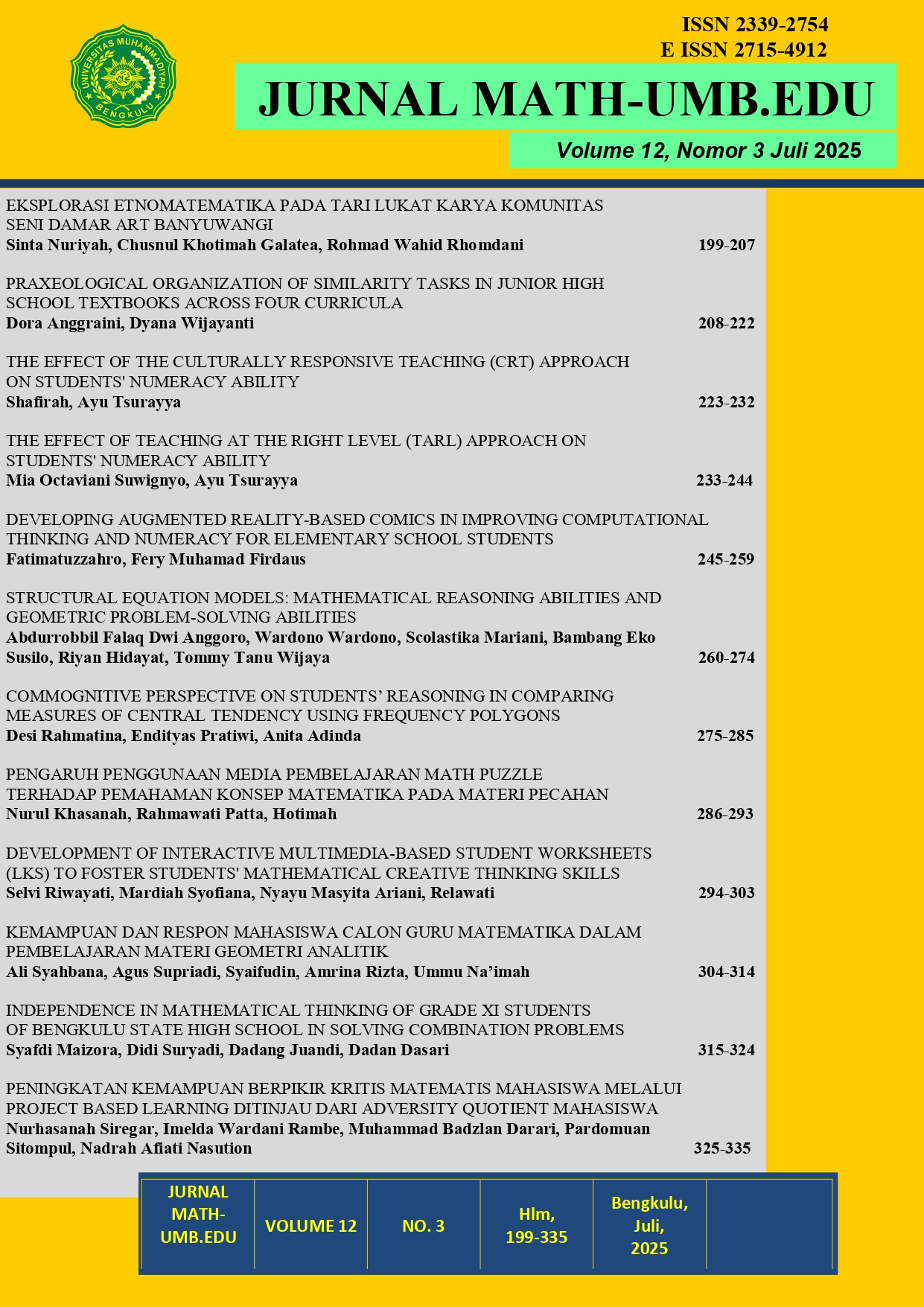DEVELOPING AUGMENTED REALITY-BASED COMICS IN IMPROVING COMPUTATIONAL THINKING AND NUMERACY FOR ELEMENTARY SCHOOL STUDENTS
DOI:
https://doi.org/10.36085/mathumbedu.v12i3.8282Abstract
This research aimed to produce augmented reality-based comics to determine the effectiveness, the worthiness, and the practicality of the comics produced in improving computational thinking and numeracy skill for fifth grade elementary school students. This research and development were carried out referring to the steps developed by Borg and Gali. Thus, indicatingthat a statement items were valid. Reliability test showed that the variables were reliable, with Cronbachs Alpha values exceeding 0,60. Reliability test for Computatinal thinking and numeracy showed reliability, with a Cronbachs Alpha value of 0,762>0,60. Data Analysis techniques included preliminary test such as normality test, homogeneity test, independent sample t-test hypothesis test and efective relative. The results of the research are as follows: (1) augmented reality-based comics according to the assessment of material experts and media experts is very worthy of being tested in research to improve students' computational thinking and numeracy skills. (2) augmented reality-based comics as media with a significance value of 0.00< 0,05. The Average pretest score for Computational Thinking and Numerasy is 48,66, while in the control class, it is 49,56. The average posttest score for Computational Thinking and Numerasy in the experimental class is 74,29, whereas, in the control class, it is 65,46. (3) Augmented reality-based comics obtained significant results in improving students' computational thinking and numeracy skills, based on the results of the t-test of post-test with a significance value of 0.00<0.05 students before and after using augmented reality-based comics.
Keywords: media, comics, augmented reality, computational thinking, numeracy
References
Akbar, S. 2013. Instrumen Perangkat Pembelajaran. Bandung: PT Remaja Rosdakarya.
Angga, P. M. W., Sudarma, I. K., & Suartama, I. K. (2020). E-Komik Pendidikan Untuk Membentuk Karakter Dan Meningkatkan Hasil Belajar Siswa Kelas V Pada Mata Pelajaran Bahasa Indonesia. Jurnal Edutech Undiksha, 8(2), 93. https://doi.org/10.23887/jeu.v8i2.28920
Anggito, A., & Sartono, E. K. E. (2022). The development of multicultural education comics to embed tolerance character for 4th grade of elementary school. Jurnal Prima Edukasia, 10(1), 66-81.http://dx.doi.org/10.21831/jpe.v10i1.40504
Arifin, A. M., Pujiastuti, H., & Sudiana, R. (2020). Pengembangan media pembelajaran STEM dengan augmented reality untuk meningkatkan kemampuan spasial matematis siswa. Jurnal Riset Pendidikan Matematika, 7(1), 59-73.
Ayuningtyas, N., & Sukriyah, D. (2020). Analisis pengetahuan numerasi mahasiswa matematika calon guru. Delta-Pi: Jurnal Matematika dan Pendidikan Matematika, 9(2).
Budiarti, W. N., & Haryanto, H. (2016). Pengembangan media komik untuk meningkatkan motivasi belajar dan keterampilan membaca pemahaman siswa kelas IV. Jurnal Prima Edukasia, 4(2), 233-242.
http://dx.doi.org/10.21831/jpe.v4i2.6295
Cabaluna, J. C. (2022). Effectiveness of Interactive Multimedia Courseware in Teaching Care Management. European Journal of Social Sciences Studies, 7(3), 9–27. https://doi.org/10.46827/ejsss.v7i3.1228
Diantary, V. A., & Akbar, B. (2022). Perbandingan Keterampilan Computational Thinking Antara Sekolah Dasar Akreditasi A dengan Sekolah Dasar Akreditasi B Pada Mata Pelajaran Matematika. Jurnal Cendekia: Jurnal Pendidikan Matematika, 6(3), 2749-2756.
Gecu-Parmaksiz, Z., & Delialioglu, O. (2019). Augmented reality-based virtual manipulatives versus physical manipulatives for teaching geometric shapes to Malaysian Journal of Social Sciences and Humanities (MJSSH). 15 preschool children. British Journal of Educational Technology, 50(6), 3376–3390. https://doi.org/10.1002/cae.22424
Hanid, M. F. A., Mohamad Said, M. N. H., Yahaya, N., & Abdullah, Z. (2022). The Elements of Computational Thinking in Learning Geometry by Using Augmented Reality Application. International Journal of Interactive Mobile Technologies, 16(2), 28–41. https://doi.org/10.3991/ijim.v16i02.27295
Indahsari, L., & Sumirat, S. (2023). Implementasi Teknologi Augmented Reality dalam Pembelajaran Interaktif. Cognoscere: Jurnal Komunikasi Dan Media Pendidikan, 1(1), 7-11.
Leonarduzzi, R., Zhang, R., & Sun, J. (2023). Simultaneous compression and stabilization of neural networks through pruning. Mathematics, Computation and Geometry of Data, 3(1), 1-28.
https://dx.doi.org/10.4310/MCGD.2023.v3.n1.a1
Lubis, A. H., & Dasopang, M. D. (2020). Pengembangan buku cerita bergambar berbasis augmented reality untuk mengakomodasi generasi Z. Jurnal Pendidikan: Teori, Penelitian, Dan Pengembangan, 5(6), 780-791.
Mardiono, T. (1998). Empat Belas (14) Jurus Membuat komik. Jakarta:Creative Media.
Masyhud, M. Sulthon, 2015. Analisis Data Statistik Untuk Penelitian Pendidikan. Jember: Lembaga Pengembangan Managemen dan Profesi Kependidikan (LPMPK)
Meilindawati, R., Zainuri, Z., & Hidayah, I. (2023). Penerapan media pembelajaran augmented reality (ar) dalam pembelajaran matematika. JURNAL e-DuMath, 9(1), 55-62.
Muhaimin, M. R., Ni’mah, N. U., & Listryanto, D. P. (2023). Peranan Media Pembelajaran Komik terhadap Kemampuan Membaca Siswa Sekolah Dasar. Jurnal Pendidikan Dasar Flobamorata, 4(1), 399-405.
Najuah, N., Sidiq, R., & Lukitoyo, P. S. (2021). The Development electronic module of history using ADDIE model. International Journal of Educational Research & Social Sciences, 2(6), 1658–1663. https://ijersc.org
Ningrum, K. D., Utomo, E., Marini, A., & Setiawan, B. (2022). Media Komik Elektronik Terintegrasi Augmented Reality dalam Pembelajaran Sistem Peredaran Darah Manusia di Sekolah Dasar. Jurnal Basicedu Vol, 6(1).
Parnabhakti, L., & Ulfa, M. (2020). Perkembangan Matematika dalam Filsafat dan Aliran Formalisme yang Terkandung dalam Filsafat Matematika. Jurnal Ilmiah Matematika Realistik, 1(1), 11-14.
Pernando, C. P., & Danang, S. (2022). Pengembangan Komik Petualangan Zahlen Sebagai Media Pembelajaran Matematika Pada Materi Bangun Ruang Sisi Datar. Mosharafa: Jurnal Pendidikan Matematika, 11(1), 131-142.
Rusmana, I. M. (2020). Pembelajaran matematika menyenangkan dengan aplikasi kuis online quizizz. Prosiding Sesiomadika, 2(1a).
Sinurat, J. A. M. T., & Fauzi, M. A. (2022). Analisis Kesalahan Kemampuan Spasial Siswa Smp Ditinjau dari Gaya Kognitif Menggunakan Pembelajaran Matematika Realistik. Journal of Comprehensive Science (JCS), 1(5), 1410-1417.
Sugiyono.2014. Metode Penelitian Kuantitatif Kualitatif dan R&D. Bandung: Alfabeta.
Suryanti, S., Mariana, N., Yermiandhoko, Y., & Widodo, W. (2020). Local wisdom-based teaching material for enhancing primary students’ scientific literacy skill. Jurnal Prima Edukasia, 8(1), 96-105. https://doi.org/10.21831/jpe.v8i1.32898
Suryatin, S., & Sugiman, S. (2019). Comic book for improving the elementary school students’ mathematical problem-solving skills and self-confidence. Jurnal Prima Edukasia, 7(1), 58-72.http://dx.doi.org/10.21831/jpe.v7i1.10747
Susanto, H. A., & Hidajat, D. (2021). Analisis Kesulitan Pembelajaran Matematika Dengan Sistem Daring Masa Pandemi Covid-19 Pada Siswa Kelas Vii Dan Kelas Viii Smp Tahfizh Al-Ittiba’klaten Tahun Ajaran 2020/2021. Jurnal Pendidikan, Sains Sosial, dan Agama, 7(1), 31-41.
Utomo, F. B. B. (2018). Developing illustrated story books to improve beginning reading skills and learning motivation. Jurnal Prima Edukasia, 6(2), 118-128. http://dx.doi.org/10.21831/jpe.v6i2.16456
Yulistia, A. (2019). Scientific-based approach pictorial storybook for eliciting creative thinking and collaborative skills. Jurnal Prima Edukasia, 7(2), 172-181.http://dx.doi.org/10.21831/jpe.v7i2.16297















